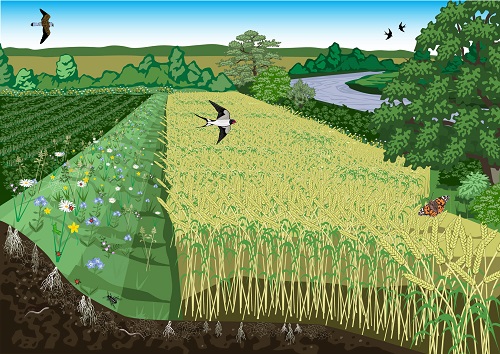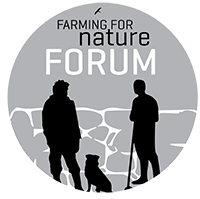TILLAGE
Here are some practical ways to take climate action and enhance biodiversity on your tillage farm
Climate & Biodiversity actions full doc (pdf)
Tillage section only (pdf)
Whilst every farm is different, every farm has something to offer to help mitigate climate change and help nature thrive, cleaner waters and improve soil biology on your land. The following are tips from other farmers compiled to help you find simple ways to improve upon these areas on your farm.
“Climate change mitigation and farming for nature go hand in hand – what benefits one is good for the other. It is very often a case of achieving better outcomes with less effort, providing you know what you are doing. Low disturbance crop establishment for instance ticks an awful lot of the boxes; less fuel and metal is used as well as protecting soil biology and retaining organic matter. Reducing hedge cutting to once every few years does very little harm to crops, has big benefits for insects and birds and involves less effort and expense. There are many more examples of an informed neglect of the farm being good for farmer, farm, nature and climate.”
Andrew Bergin, Tillage farmer & FFN Ambassador, Co. Kildare.
1. Soil
Don’t treat your soil like dirt! Healthier soil can increase yields, retain more moisture, store more carbon and support more biodiversity!
- Maintain aerated soils by avoiding compaction from increasingly heavy farm machinery
- Capture and store maximum soil carbon by minimising inversion ploughing – try min-till where possible
- Compost your vegetative waste!! – check out the many online videos to learn how to make nutrient dense compost fertiliser
- Diverse rotations are key to soil health – try catch, combi, cover, and double-cover crops in your rotations
- Consider cultivating in spring rather than autumn
- Build soil fertility and store carbon by keeping soil covered – try catch and cover crops and green manures and don’t leave soil exposed!
- Increase organic material by adding farmyard manure and crop residues to your soil
- A single cubic inch of soil can contain eight miles of mycelia – naturally occurring fungal hyphae that boost soil fertility. Allow these engines of growth to work for you by avoiding fungicides where possible
- Try biostimulants and nature-friendly inoculants (e.g. vermi-liquid or compost fertiliser) instead of chemical seed and soil treatments
- Experiment with soil building techniques from regenerative farming, permaculture, organic farming, or Korean Natural Farming
- Get to know your soil! Discover more about your own soil by exploring apps and online resources, or by digging some holes!!
Co-benefits for farmers
Healthy soil:
- increases yields
- has a higher level of available nutrients for crops (meaning less fertilizer is used)
- is easier to cultivate (meaning less diesel is used)
- retains more moisture (making crops more drought tolerant)
- drains better (making land more flood resistant)
- supports more soil microbes (which in turn store more carbon and lead to even healthier soils!)
Norman Dunne, Tillage farmer & FFN Ambassador, Co. Meath:
“One of the easiest actions we have taken was to simpl(y) grow a covercrop. By simply planting a covercrop you will
- Improve water filtration and percolation.
- Mop up any available nutrients.
- Keep live roots in the ground.
- Improve water quality.
- Make your soil more friable (important (for) till or no-till as it will reduce metal ware and diesel consumption)
- Keep your soil open and reduce compaction.
- Improve microbial life which will cycle locked up nutrients.
- Create more habitats and food for ground nesting birds and also mice and frogs for foxes, badgers, owls and birds etc.”
2. Trees, scrub & hedgerows
Woody vegetation captures carbon.
- Allow natural regeneration of trees and scrub in less productive areas or difficult corners
- Plant diverse native hedgerows
- Allow existing hedgerows to grow tall and wide
- Diversify farm enterprises by planting a native woodland
- Retain existing hedgerows, woodland, copses and scrub
Co-benefits for farmers
In a tillage system, woody vegetation can provide
- shelter-belts for crops
- habitat for beneficial predatory insects
- better-connected and richer wildlife habitats
- improved drainage and water quality
- reduced soil erosion
“Another simple measure we have implemented to support nature is rotational hedge cutting. Cutting every second year and letting the hedges grow higher has proven successful in creating habitat and shelter areas” Norman Dunne, Tillage farmer & FFN Ambassador, Co. Meath
3. Nutrient management
The manufacture of chemical fertilisers generates ~1.4% of all carbon dioxide emissions. Furthermore, the application of fertilisers releases nitrous oxide, a gas with 300 times the global warming potential of carbon dioxide. Reduce use by increasing efficiency:
- Maximise nutrient uptake by crops by maintaining optimum soil pH
- Choose crops that require fewer chemical treatments and are naturally resilient to climate change (e.g. more extreme droughts, floods or winds)
- Build fertility using catch crops, cover crops and green manures
- Spread fertiliser on warmer days (soil temp at least 6°C) to maximise absorption
- Include nitrogen fixing legumes in your crop rotations (e.g. peas, vetch, beans)
- Try simple mobile phone operated GPSs and tractor sensors to ensure more targeted use of inputs
- Explore alternatives to chemical fertilisers (e.g. compost, organic manures)
Co-benefits for farmers
- Decreased fertiliser use (lower costs)
- Increased farm self-sufficiency (lower external inputs)
- Improved soil fertility (increased yields and climate resilience)
- Greater resilience to both shifts in market forces (less reliance on expensive external inputs) and to extreme weather events (e.g. droughts and floods)
4. Water management
Our water bodies (rivers, lakes and oceans) naturally work together to support biodiversity and to store carbon. When water bodies are polluted, these systems break down. Almost half of Irish surface waters are not in good health and the situation is deteriorating. Help to restore our water bodies by eliminating harmful farm run-off:
- Treat your chemicals with extreme care – just one drop of pesticide can pollute a small stream for over 30kms!! Reduce the need for pesticides by boosting populations of predatory insects: create or enhance hedgerows and field margins as habitats for predatory insects (e.g. ladybirds and spiders). These will move onto the crop in spring, naturally reducing the pest burden.
- Reduce herbicide use by using alternative methods of weed control e.g. non-synthetic herbicides, mulching and diverse crop rotations. As many synthetic herbicides are water soluble (e.g. MCPA, 2,4-D), it is almost impossible to ensure they do not end up in watercourses after application!
- Reduce run-off from fields by slowing the flow of surface water: plant buffer strips, field margins and native hedgerows; never spread or spray when rain is due.
- List the potential sources of run-off from your farm and how you might eliminate them. Some of these (e.g. herbicides, pesticides, fungicides) are more obvious than others (e.g. spoil from tractor tyres, washings or sediment from soil erosion).
- Eliminate costly waste – use fertilizers, herbicides, pesticides, fungicides, molluscicides and chemical seed treatments only where needed
- Every drop counts! – Treat any spray residue from washings, tanks and storage containers with respect
Co-benefits for farmers
- Reduced input, labour, fuel and machinery costs
- Cleaner water – research has detected herbicides in 38% of drinking water wells tested in Ireland!
- A healthier working environment for the farmer, the farm family, the local community and for future generations!
5. Energy & fuel
Maximise energy efficiency and reduce fossil fuels to minimise your carbon footprint!
- Turn the engine off rather than letting it idle
- Shift up a gear and throttle back for lighter work or on the road
- Remove unnecessary tractor weights – doing so can save over one litre of diesel/hr!
- Check tyre pressure regularly (lowering pressures for field work will reduce fuel use)
- Mend leaky pipes, troughs or taps – drinking water production and supply requires energy yet >43% of treated drinking water in Ireland is lost to leaks!
- Consider installing renewable energy A shed roof can be the ideal place to install solar panels and supports are increasingly available.
- Reduce the use of plastics, fertilisers, herbicides and pesticides, which are all manufactured using fossil fuel based products.
- Consider using solar water pumps – the technology and cost has greatly improved in recent years
- Heat pumps can be a good alternative to fossil fuel based heating systems
- Take care when opting for ‘degradable plastics’ – many products will leave plastic residues in your soil
- Cut down route-to-market costs by selling direct to consumer and transport emissions by selling locally where possible
- Minimise food waste and make sure to compost any vegetative waste – it’s a valuable resource!
- Harvest water from buildings – using this ‘grey water’ to grow crops can save money and energy
Co-benefits for farmers
- Reduced fuel and input costs
- Reduced energy costs
- Improved farm self-sufficiency and climate resilience
Have you run the numbers?
“You can’t go green if you end up in the red but farming for nature can improve your income as well as the environment. Switching from conventional crop establishment to a no-till system brings big savings in machinery costs but the time I don’t spend on the seat of a tractor needs to be spent looking after my soil if the system is going to work. And that care for the soil can also bring savings as the amount of fertilisers and pesticides used will reduce as soil health improves. Done properly, this system gives me the same average yields at lower cost. I don’t work harder, just differently.” Andrew Bergin, Tillage farmer & FFN Ambassador, Co. Kildare.
“Any commercial farmer wishing to remain profitable, has to get an understanding of the restrictions that are coming down the track. This will require them to familiarise themselves with the role balanced plant nutrition plays in reducing artificial fertiliser and pesticides use.” Colm Flynn, Tillage farmer and FFN Ambassador, Co. Kildare.
“It can be very hard to realistically pinpoint how much difference there is economically because while there are savings e.g. direct drilling v.s ploughing there can be yield penalties for a few years. So I would rather look at it over a longer period of time and how building healthy soils will have a long term effect on margin and environmental impact. This doesn’t happen overnight (…). I am confident that in the long term it’s better in every way” Mervyn Aughmuty, Tillage farmer & FFN Ambassador, Co. Roscommon.
Going organic: Have you run the numbers for going partly or fully organic? New supports, lower input costs, and a growing market are making this an increasingly attractive and more climate-friendly option for tillage farmers.
Nature co-benefits
Climate action on tillage farms can benefit nature by creating:
- More species-rich and diverse landscapes, supporting native fungi, insects, birds, mammals and more!
- Healthier rivers, lakes, estuaries and oceans, rich with life
- Habitat for our native species to feed and breed
- Nature-rich farms – loud with humming insects and singing birds
- A model for other tillage farmers; when we experience nature on another farm we are more likely to want to protect it on our own!
Nothing beats nature for providing natural climate change adaptation and mitigation. Boosting biodiversity, from the soil to the treetops, will help your farming system to remain productive and resilient in the face of increasingly unpredictable weather events
Please view the other farming sectors here


